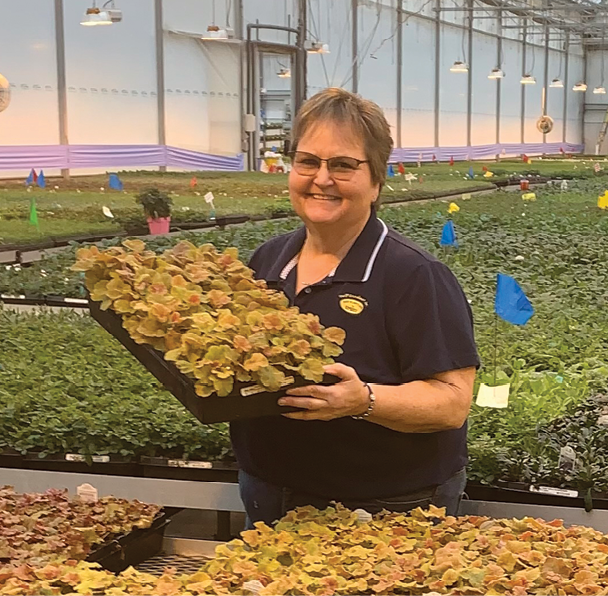
Elaine Peiffer used to say that she’d never work in a greenhouse. After growing up on a farm in Northwest Iowa, picking irises and peonies in her mother’s flower garden and interning at the Chicago Botanic Garden and Dow Gardens in Michigan, Peiffer decided that she wanted to work outside in gardens, just not under glass.
But then her horticulture advisor at Iowa State University — the late Dr. David Koranski, a pioneer in plug production — encouraged her to pursue an internship in a greenhouse. A fellow classmate of Peiffer’s named Scott Swift — who was preparing to graduate and join his family’s operation, Swift Greenhouses Inc., in rural Gilman, Iowa — suggested that she work with him.
Since that internship in 1987, Peiffer has spent her entire horticulture career in greenhouses. She worked at Dallas Johnson Greenhouses in Council Bluffs for eight years, then Red Oak Greenhouses in Red Oak, Iowa, for five, before running into Scott Swift again at an industry event. He mentioned that he was considering hiring another grower, and Peiffer asked, “How about me?” She rejoined Swift’s team in 2000, bringing her career full circle back to the same greenhouse where it began.
Now as senior grower supervisor, Peiffer is applying decades of knowledge to keep Swift’s perennial plug production on schedule as she strives to keep improving every season.

Expanding production
From the time Peiffer interned at Swift in 1987 to the time she returned in 2000, a lot had changed at the greenhouse. During her internship, the greenhouse consisted of several old Quonset huts, where she grew 288 plugs on wooden benches with forced air heat from oil burners. She returned a dozen years later to find the Quonset huts replaced by gutter-connected greenhouses, and a brand-new plug production range with under-the-bench heating.
Swift has continued to evolve and expand since then. “It’s been fun to see how we’ve grown and changed over the years,” Peiffer says. “When I started in 2000, we had two acres, and now we’re about six acres. Every year we just keep adding varieties. When I started, we had three to four pages on our order form, and we’re now up to 11 pages.”
Today, Swift grows more than 1,500 varieties of perennials, herbs and annuals in both plugs and finished pots (the latter of which makes up about 40% of the business). Peiffer and her team focus on 275 plugs and large 50 plugs that are vernalized, or cold treated, and sold as mature, dormant root systems that flower the first year — unlike most perennials, which don’t flower until their second summer in the garden.
To achieve optimal plant growth in customers’ gardens across the country, Peiffer and her team are constantly improving their growing processes and systems in the greenhouse. Over time, they’ve added more benches with bottom heat, installed more high-intensity discharge lights and invested in brand-new seeding equipment and soil mixers to provide the best environment for each variety.



Knowing each crop
Every decision Peiffer makes as a grower “goes back to knowing our crops,” she says — in other words, understanding the environmental conditions, growing media and inputs each variety requires to thrive. It’s not just knowing which greenhouse each crop grows best in, but specific locations within each range, due to nuanced microclimates.
“Learning crop placement is huge,” Peiffer says. “We have databases, even for where they go in the greenhouse for cold treatment and where they need to be for proper growth.” Swift’s database also tracks fertilizer formulations throughout the season and the growing cycle, along with fungicide and insecticide applications and plant growth regulators (PGRs) for each variety.
Peiffer admits that when she first joined Swift, she only knew about 10 perennials by name from her mother’s garden. Over the last 37 years in the industry (including 24 at Swift), her plant knowledge has multiplied as the greenhouse inventory has expanded. The challenge, she says, is bringing new growers up to speed by sharing the knowledge she’s gained throughout her career.
To that end, Peiffer is continuously training her growers on varying crop cultures, “so they can recognize good plants and problems in their plants,” she says. “I’m always trying to teach them to read the crop.”
In addition to one-on-one coaching, Peiffer uses trials as a teaching tool to show growers how their decisions impact each plant. Peiffer encourages her team to experiment with fertilizers, growing media and PGRs, “so they can see the difference in how plants react to a different environment,” she says.
In fact, she says, that experimental mindset is key to growing plants. Her advice to other growers is: “Be open to learn more all the time, to try new things, experiment and run trials. [Keep asking] ‘What can we do to make things better? How can we improve this crop?’ And learn from your mistakes — always being humble and knowing you’re not perfect, but just keep plugging away.”

Explore the March 2024 Issue
Check out more from this issue and find your next story to read.
Latest from Greenhouse Management
- Anthura acquires Bromelia assets from Corn. Bak in Netherlands
- Top 10 stories for National Poinsettia Day
- Langendoen Mechanical hosts open house to showcase new greenhouse build
- Conor Foy joins EHR's national sales team
- Pantone announces its 2026 Color of the Year
- Syngenta granted federal registration for Trefinti nematicide/fungicide in ornamental market
- A legacy of influence
- HILA 2025 video highlights: John Gaydos of Proven Winners





